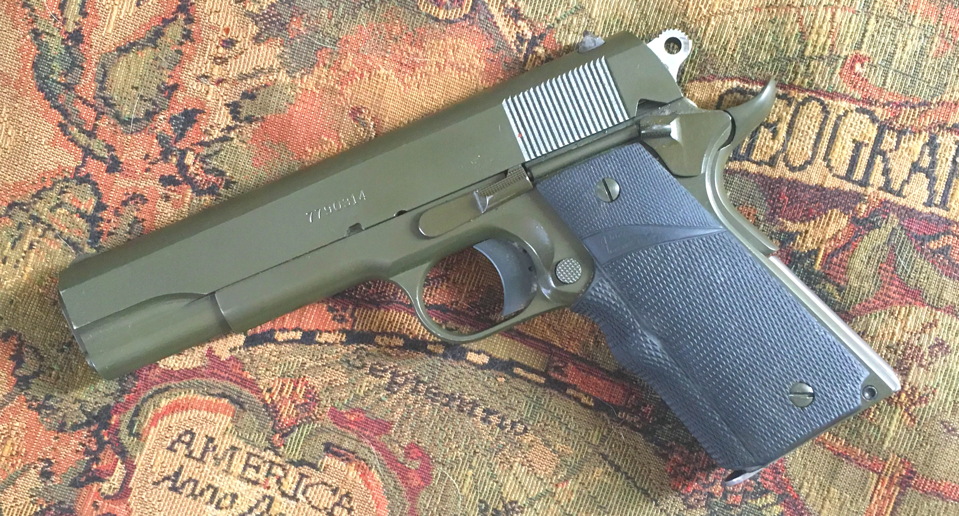A good few years back a friend came to dinner, bringing a 1911a1 in a box, fully disassembled. He’d put it together a decade before and sent it off for a green Teflon coating that had been all the rage at that time. While he had been waiting to get it back he had become a ‘Glock Guy,’ and had never gotten around to reassembling it, and sheepishly admitted he’d forgotten how… would I mind?
I grabbed us some coffee and after a couple minutes the gun was back together. He then produced several extra magazines, a magazine pouch, holster, several manuals and said, “Merry Christmas.” It was nowhere near Christmas, of course, but I got the point. I thanked him profusely and we had a nice dinner and a good evening.

The gun was a Frankengun, with a WW2-era slide, a surplus frame of some kind, with GI sights and controls. It had Pachmayr grips and a Pachmayr arched mainspring housing, a beavertail grip safety, commander’s Hammer and a target trigger… and it was green. Baby-shit green; the picture really doesn’t do it justice. Trust me.
For some time the only modification I made was to the grip, using my secret finger-groove method to produce a single groove immediately under the trigger-guard. OK, it’s not much of a secret- I super-glued a piece of eraser to the grip-frame and stretched the Pachmayrs front-panel over it.
I have a large hand, so the next modification was a flat mainspring housing from Caspian, courtesy of my friend Jim. Between this and the finger grove I enjoyed this gun quite a bit more. It has a very good trigger; not ‘Steel Challenge’ good, but a good weight with minimal over-travel and a fast, positive reset. It’s also been very reliable; I can’t remember a single malfunction in 500-600 rounds. Ball, SWC, hollow-points, it just doesn’t care. But those sights!
I love a good 1911, but between the ugly green finish and poor sights this one wound up not getting a lot of range time. Eventually I enlarged the notch on the rear sight and modified the front sight a bit, and it was… less bad.
The other day I was finishing up work and thought, ‘Why don’t I stipple the mainspring housing? Gives a better grip, and it’s not rocket science…’ I pulled the housing, chucked it up in a small bench vise, grabbed a center-punch and hammer and went to town. The result was really nice, but it was… sparkly. Yeah, no. I disassembled it and dropped it into some Ferric Chloride for a 1/2 hour or so. That gave it a nice matte gray finish, and I reassembled the housing and installed it. All to the good. But those sights, and that slide…
There was one entirely functional modification I wanted- to bevel the magazine-well. Not that this had ever been a problem, but it’s a good thing to have; gives you just a little margin for error when doing a quick reload.
The ugly green coating was not the only cosmetic issue. While there is no faulting the interior machining of the slide the outside looks like it was finished with coarse sandpaper. Look, I get it. They were in the middle of a world-war; it needed to work. Who gave a crap if it was pretty? I needed better sights anyway so what the hell; might as well fix it..
I drove the rear sight out of it’s dovetail- no mean feat, as it was basically painted into the gun- and ground off the staked GI front sight. I flattened the top of the side on the belt-grinder, then got out my 10″ Diamond Hone sharpening stone and went to work getting it really flat. I repeated the process on the flats on the sides of the slide, then using a small triangular file I carefully removed the coating from the slide serrations. I sanded the upper curved surfaces of the slide as well, but made no effort to fully finish them. I also left the recoil-spring housing under the barrel and the back of the slide green to match the frame, producing a two-tone finish.
I stripped the finish from the modified rear sight and re-installed it, then moved on to the front sight. I know big, fat front sights are the fashion, but back when I was shooting IPSC I always likes a narrow front sight; it didn’t slow me down and gave me better precision on the rare long-range shots. I used a cut-off wheel to make a slot in the front of the slide, the cut and fitted a piece of brass plate and silver-soldered it in place. I cleaned up around the sight, then cut it to my best guess for the correct height. I tried to err on the side of making it too tall rather than too short; easier to adjust by removing material.
After that I sanded the exposed metal with 240-grit paper and rust-blued the slide using Mark Lee #1 Instant Rust Blue. I reassembled the slide and put the gun back together. I don’t know how much better it’s going to shoot, but it seriously looks better!
Now that the green is restricted to the lower half of the gun I find I don’t so much mind it. I’ll take it out the the range in the morning as see what’s what, but I have to say I really like the changes. This could be the start of a beautiful relationship…
Michael Tinker Pearce, 4 November 2020
If you like what you read here, please consider clicking the link above and supporting me on Patreon.